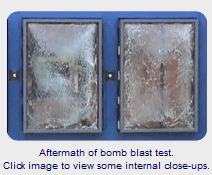Bomb Blast / Terrorism
Note: It is important to point out that security film, with or without an anchoring system, cannot guarantee a low hazard level during a bomb blast. There are far too many mitigating circumstances that can reduce the level of protection – excessive blast force, large missile projectiles, etc... Security film can increase the level of protection, not guarantee it.

There is no place in the world today that is safe from a terrorist bomb blast. Government buildings and other high profile locations are attractive targets for terrorist organizations. In some cases, even public places like restaurants, clubs and office buildings are prime targets for terrorists looking to inflict as much human suffering as possible. In 2004 there were 3,192 separate terrorist incidents around the world (most of them using some type of explosive device) involving 28,433 victims and 6,060 deaths. Unfortunately, terms like “9-11” and “Oklahoma City” are part of our daily vernacular.
Even the United States government has documented the dangers of glass during a bomb blast attack. Sadly, a major report to the Secretary of Defense was commissioned only after the devastating attack on the American compound in Saudi Arabia in 1996. The Force Protection report (Click here for report details) pointed out that many deaths occurred solely and specifically from flying glass injuries during the attack. It also showed a recommendation to install protective window film was made long before the attack, but unfortunately it was postponed. A conclusion can be drawn that fatalities could well have been avoided if protective window film had been installed.

Accidental blasts have also known to occur at industrial plants such as refineries with similar lethal results. People located inside a building or home are unprotected when a bomb blast occurs within striking distance. The magnitude of the force blows out the glass and propels broken shards at a deadly speed of over 100 mph cutting through anything in its path. Flying glass is the #1 cause of injury when a bomb blast occurs outside of a dwelling.
Fortunately, the implementation of security film along with a quality window anchoring system is an effective way to increase protection and reduce the glass hazard level caused by terrorist bomb blasts
(Click here for details). When a bomb blast occurs, security film will act as a protective net to keep broken shards together while the anchoring system provides a stronger hold to the entire glazing system.
Johnson Window Films' 8, 11 and 12 mil Trident Security films, in conjunction with an anchoring system, are recommended for glass hazard mitigation against terrorist bomb blast occurrences. These films offer increased protection without eliminating the necessary viewing function of a window. The selection of film often depends on the proximity to a potential bomb blast danger area; if you are close to a prime target an 8 or 11 mil. Security film with a retention system is probably necessary while windows farther away (e.g. 5 to 10 blocks) might only need a 7 or 8 mil Security film without a retention system.

JWF Security Films successfully pass
GSA/ISO Bomb Blast Test
JWF Security film has met rigorous government certification requirements by passing national and international explosion resistance standards set forth by the GSA and ISO. Not only did JWF Security films meet the minimum requirements, but in some cases the films passed when tested using double the required blast pressure. Note that testing only allows comparison of a system against a set standard. It does not acknowledge variations in specific applications such as windows, frames, walls etc.
Click Here for more information about bomb blast testing.
Click Here to view JWF's bomb blast test results.
- Learn More
- Anti-Graffiti / Vandalism
- Residential Safety
- Commercial Security
- Windstorms
- SEISMIC
- Bomb Blast/ Terrorism
- Anchoring Systems


